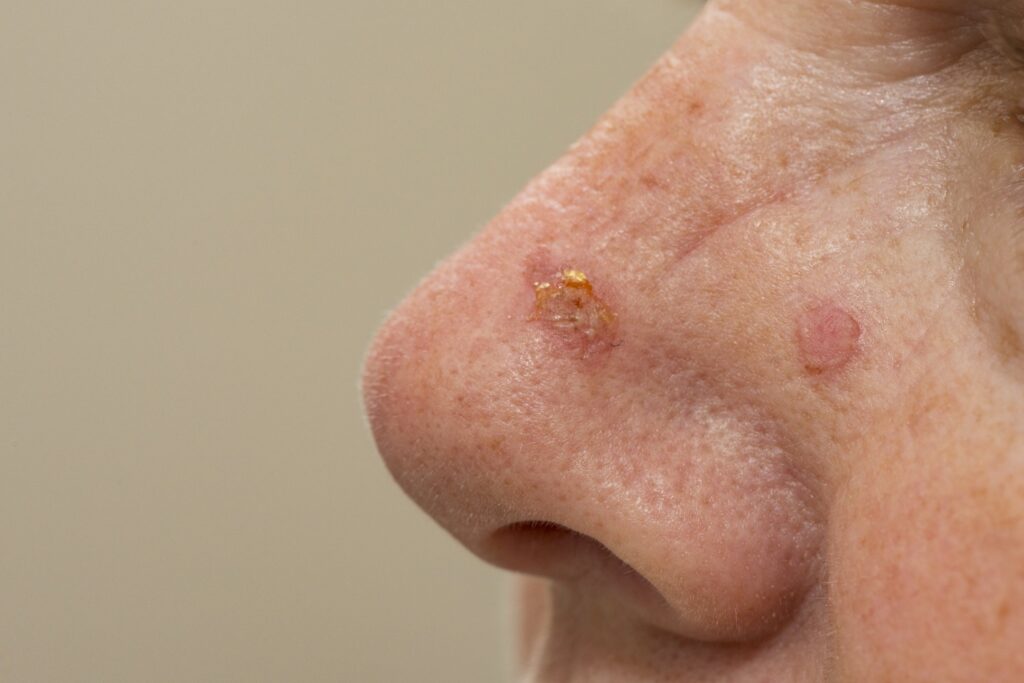Actinic Keratosis
What is actinic keratosis?
Actinic keratosis (AK), also known as solar keratosis, is characterized by scaly patches or bumps that have a pink or red base and can be found on parts of the body that have been exposed to the sun. This could be on the hands, arms, face, lips, neck, scalp, and ears.
This condition is most common in individuals with fair skin, as well as individuals over the age of 40.
While many cases of AKs don’t become squamous cell carcinoma (SCC), there is a concern due to the fact that many cases of SCC develop from pre-existing AKs. Unfortunately, AKs that do develop to SCC can’t be segmented out from AKs that don’t develop into SCC. Due to this, many dermatologists will treat AKs on a routine basis.

What are symptoms of actinic keratosis?
AKs most often don’t present any symptoms. Patients with AK have noticed lesions that are flat or raised that tend to feel like sandpaper.
What causes actinic keratosis?
AKs can be caused by significant sun exposure over the years.
How is actinic keratosis diagnosed?
To be diagnosed with AK, your dermatologist will give you a physical examination. If your dermatologist can’t diagnose you through an exam, they may order a skin biopsy.
What is the treatment of actinic keratosis?
AKs can disappear without treatment; however, this condition typically returns if the individual is exposed to the sun frequently.
Due to the fact that it can’t be determined if AKs will develop into SCC, all AKs are treated as a precaution. Four common treatments include:
- Cryotherapy (freezing through liquid nitrogen): This is the most common treatment for AKs. After treatment, the treated area will become blistered and begin to peel after a couple of days. Once your skin is healed, new skin will appear.This treatment’s side effects could include blistering, scarring, skin texture and skin tone changes, and possible infection.
- Medications: If a patient has multiple AKs, a dermatologist may prescribe a cream for the areas such as fluorouracil cream, imiquimod cream, ingenol mebutate gel or diclofenac gel. Side effects of this treatment could include redness in the skin, scaling or a burning sensation.
- Curettage (scraping of the skin): If your dermatologist recommends scraping off the skin, they will use a device called a curet, which is then followed by electrotherapy. This will remove any damaged cells. During this treatment, you will be given an anesthetic. Side effects of this treatment could include possible infections, scarring of the skin and skin discoloration.
- Photodynamic therapy (PDT): PDT is a non-invasive therapy that uses multiple light treatment sessions in conjunction with a photosensitizing agent. PDT treatment will be repeated six weeks after the first treatment.This treatment’s side effects could include redness and swelling of the skin and a burning sensation during therapy.
- Chemical peel: This is a medical-grade chemical peel used to destroy the top layers of skin and cannot be performed at a medical spa or from a kit sold for home use.
Depending on your diagnosis, a combination of treatments may be recommended.
How can I prevent actinic keratosis?
You can prevent the risk of develops AKs by:
- Protecting yourself from the sun: Avoid the sun during peak hours.
- Wear protective clothing: This could include sunglasses, long-sleeve shirts and hats.
- Use sunscreen and sunblock.
For those who have AKs, they will need to be seen yearly to monitor your condition.
How can my dermatologist help?
If you believe you have AK or aren’t sure, a dermatologist can diagnose you and provide effective treatment.
Our staff is dedicated to keeping up-to-date with the most advanced procedures and patient education. If you are experiencing acne and would like a consultation, please contact us.
Dermatology Center for Skin Health, PLLC
600 Suncrest Towne Centre, Suite 115
Morgantown, WV 26505
Our office is located on the ground floor of the 600 Suncrest Towne Centre Building. Please enter through the middle doors at the front of the building. The Dermatology Center for Skin Health, PLLC entrance is located just inside the building — first door on the right.
You can also text us to make an appointment.
To communicate with us from a mobile phone click the button below or send a text to the number.

